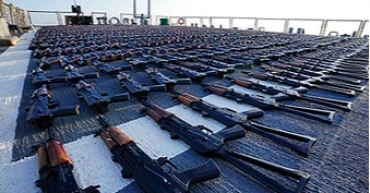U.S. Navy
US Navy says it seized Iran assault rifles bound for Yemen
The U.S. Navy seized over 2,100 assault rifles from a ship in the Gulf of Oman it believes came from Iran and were bound for Yemen’s Iranian-backed Houthi rebels, a Navy spokesman said Tuesday. It was the latest capture of weapons allegedly heading to the Arab world’s poorest country.
The seizure last Friday happened after a team from the USS Chinook, a Cyclone-class coastal patrol boat, boarded a traditional wooden sailing vessel known as a dhow. They discovered the Kalashnikov-style rifles individually wrapped in green tarps aboard the ship, said Cmdr. Timothy Hawkins, a spokesman for the Navy’s Mideast-based 5th Fleet.
Experts examining photos released by the Navy later said the weapons appeared to be Chinese-made T-56 rifles and Russian-made Molot AKS20Us. Type 56 rifles have been found in previously seized weapons caches. Similar green tarping also has been used.
The Chinook, along with the patrol boat USS Monsoon and the guided missile destroyer USS The Sullivans, took possession of the weapons. They resembled other assault rifles previously seized by the Navy, suspected to be from Iran and heading to Yemen.
“When we intercepted the vessel, it was on a route historically used to traffic illicit cargo to the Houthis in Yemen,” Hawkins told The Associated Press. “The Yemeni crew corroborated the origin.”
The Yemeni crew, Hawkins added, will be repatriated back to a government-controlled part of Yemen.
Read more: Iran deal tantalizingly close, but US faces new hurdles
A United Nations arms embargo has prohibited weapons transfers to the Houthis since 2014, when Yemen’s civil war erupted.
Iran has long denied arming the Houthis even as it has been transferring rifles, rocket-propelled grenades, missiles and other weaponry to the Yemeni militia using sea routes. Independent experts, Western nations and U.N. experts have traced components seized aboard other detained vessels back to Iran.
Iran’s mission to the United Nations did not respond to a request for comment Tuesday.
The Houthis seized Yemen’s capital, Sanaa, in September 2014 and forced the internationally recognized government into exile. A Saudi-led coalition armed with U.S. weaponry and intelligence entered the war on the side of Yemen’s exiled government in March 2015. Years of inconclusive fighting has pushed the Arab world’s poorest nation to the brink of famine.
A six-month cease-fire in Yemen’s war, the longest of the conflict, expired in October despite diplomatic efforts to renew it. That’s led to fears the fighting could again escalate. More than 150,000 people have been killed in Yemen during the conflict, including over 14,500 civilians.
There have been sporadic attacks since the cease-fire expired, though international negotiators are trying to find a political solution to the war.
Read more: US adds new sanctions and reward to further pressure Iran
In November, the Navy found 70 tons of a missile fuel component hidden among bags of fertilizer, also allegedly from Iran and bound to Yemen.
2 years ago
US sails warships through Taiwan Strait in 1st since Pelosi
The U.S. Navy is sailing two warships through the Taiwan Strait on Sunday, in the first such transit publicized since U.S. House Speaker Nancy Pelosi visited Taiwan earlier in August, at a time when tensions have kept the waterway particularly busy.
The USS Antietam and USS Chancellorsville are conducting a routine transit, the U.S. 7th Fleet said. The cruisers “transited through a corridor in the Strait that is beyond the territorial sea of any coastal State,” the statement said.
China conducted many military exercises in the strait as it sought to punish Taiwan after Pelosi visited the self-ruled island against Beijing's threats.
Read:Taiwan: China, Russia disrupting, threatening world order
China has sent many warships sailing in the Taiwan Strait and waters surrounding Taiwan since Pelosi's visit, as well as sending warplanes and firing long-range missiles. It views the island as part of its national territory and opposes any visits by foreign governments as recognizing Taiwan as its own state.
The U.S. regularly sends its ships through the Taiwan Strait as part of what it calls freedom of navigation maneuvers.
The 100 mile-wide (160 kilometer-wide) strait divides Taiwan from China.
3 years ago
Navy to overhaul its education system as US advantages erode
The U.S. Navy is overhauling its approach to education because the nation no longer has a massive economic and technological edge over potential adversaries, according to a strategy it is releasing Monday.
5 years ago


.jpg)
